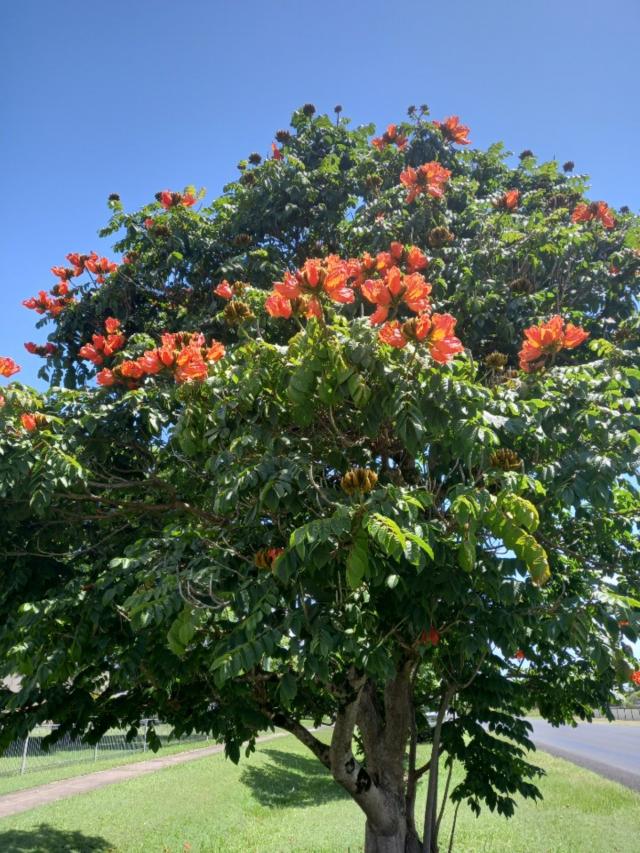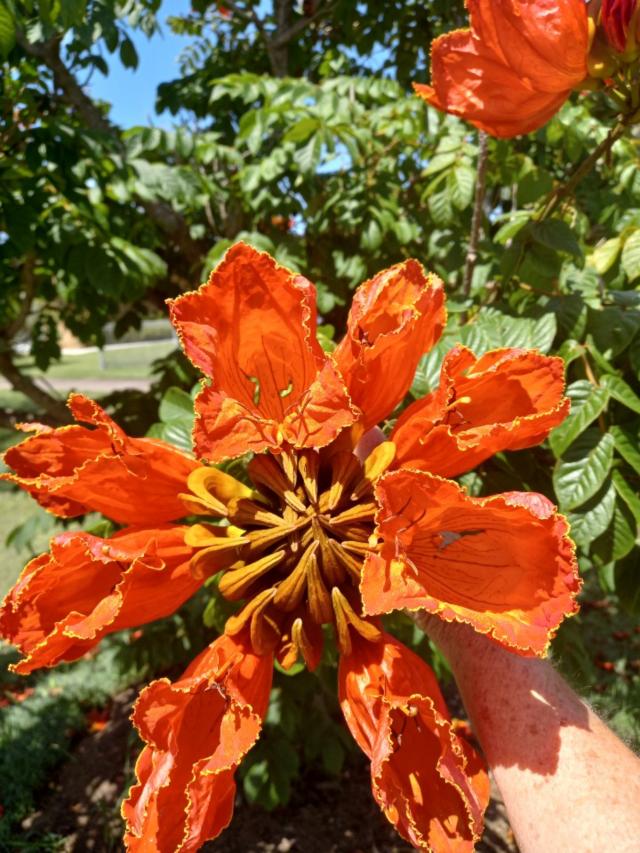By Beatrice Hawkins
By the time you read this I will be home again after having a lovely trip over the mountains to see some family for the first time in many months.
The scenery on my drive was spectacular given the beautiful season we are enjoying with everything green and flourishing. Should have stopped and taken pictures as I saw some really lovely sights. Somehow they always seemed to be where it was not convenient or safe to pull over. One such sight was a herd of Limousin and Angus cattle in prime condition and up to their bellies in green feed.. what a sight!.. made this ex cattle producer’s heart sing! I must make more of an effort to stop and take the pictures.
As you all know I love trees and the poincianas are looking particularly pretty at the moment with the profusion of bright orange red flowers showing over the lovely bright green feathery leaves. This year I have noticed for the first time white petals in the centre of each flower looking for all the world like a white feather.
When I read about the tree I found that it is not uncommon for them to have this. The flower consists of 4 orange red large petals with a central “standard” with white or yellow colouring. As I haven’t spent a lot of time in areas where these wonderful trees grow, I hadn’t seen it before.. or perhaps I’ve never been around when the flowers were out like they are at present. Just now, many of the trees look as if they have small white birds dotted all over them.
Delonix regia is the botanical name and it is a legume, a part of the bean family. This is evident when the flowering tapers off and the long green beans set on the tree. These then turn brown and can be readily germinated to grow. The seeds can be poisonous to animals but are edible once boiled. The tree is native to Madagascar but is grown worldwide in suitable tropic to semi tropic climates for its wonderful flowers and fern like leaves. Not a good plant to grow to close to a house as it has a very invasive root system. I have seen them grown as a street tree and they provide wonderful shade but, given the nature of the root system, they are probably not a very good choice.
Another tree I have admired for years in coastal regions of N.S.W. is the African tulip tree and at present they are flowering well in many areas.
However, when I researched them, they also are a bother and apparently no longer allowed in Queensland. They are an environmental weed and spread easily by seed. They are very hardy and dry tolerant but prefer damp conditions and their roots will seek out moisture. With the windblown seed settling in gullies and creeks, they really become a problem.
They are also a rapid grower and can reach to about 25 metres. They are hard to get rid of as they sucker prolifically when cut down if the stump is not poisoned or removed entirely. I have read of an instance where one tree was cut down and now there is almost a forest of suckers causing havoc to surrounding buildings, swimming pools, water systems and pathways with their extremely invasive roots. They are listed in the top 100 world wide list of invasive trees! As is all this is not enough reason to get rid of them, they are toxic to native bees!
They are very attractive to the bees but tend to kill them very quickly with dead bees being found in the flowers. They are very attractive to birds and bats who seem to be their major pollinators.
Obviously from their name they are native to Nigeria and other West Africa countries where they grow in the tropical rainforest.
The botanical name is Spathodea campanulata and is reported to be used in the African areas as an anti convulsent and for the treatment of epilepsy, also for the treatment of kidney disease and as an antidote against animal poisons.
Given all that I have found about this beautiful tree I guess I am going to have to change my mind!
However, with research, I found an alternative in the fire wheel tree, stenocarpus sinuatus, an Australian native to rainforest areas from Nambucca in N.S.W. to the Atherton Tablelands, where it can grow to 30 metres tall. In a garden situation or street scape and in cooler climates, it is more likely to only reach 10 to 15metres. It has beautiful, bright red, wheel shaped flowers in late summer and glossy green leaves.
Another obvious choice for me would be any one of the wonderfully coloured flowering gums available as full size or dwarf varieties. Perfect in many situations and with the dwarf variety used in the median strip on the New England Highway at Tamworth where they look terrific.








